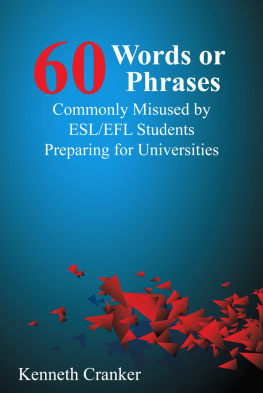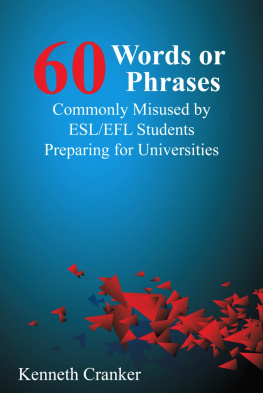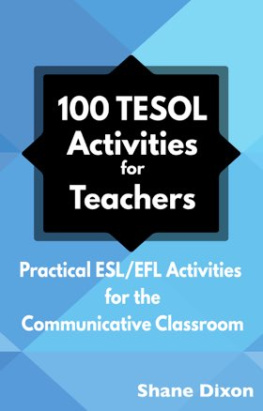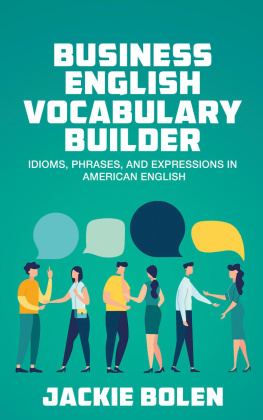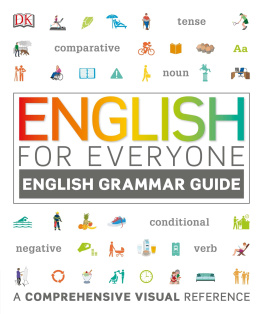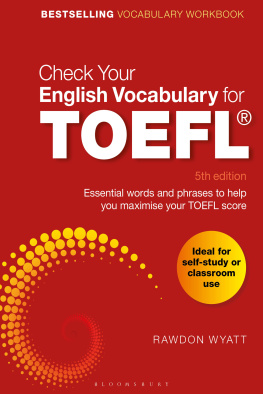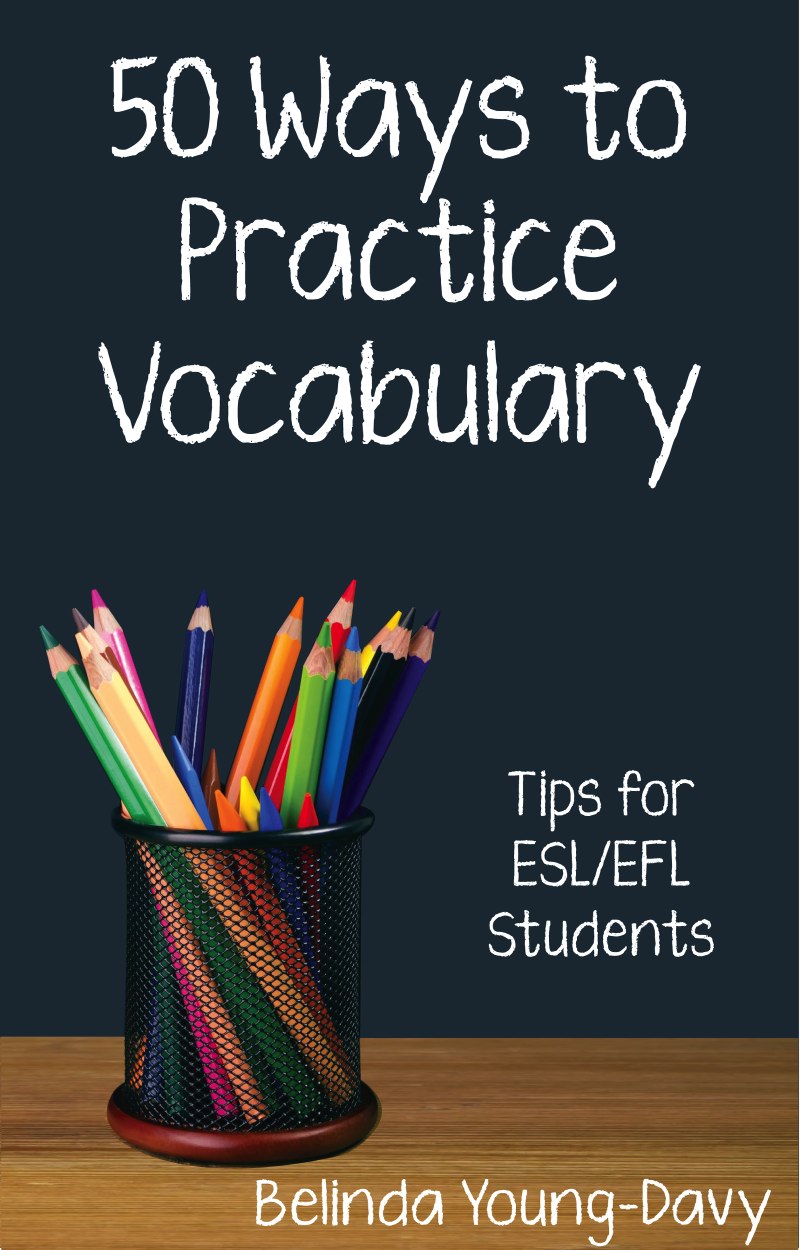Fifty Ways to Practice Vocabulary
Belinda Young-Davy
Contents
F ifty Ways to Practice Vocabulary : Tips for ESL/EFL Students
Copyright 2013 by Belinda Young-Davy
A ll rights reserved . No part of this publication may be reproduced, stored in or introduced into a retrieval system, or transmitted, in any form, or by any means (electronic, mechanical, photocopying, recording, or otherwise) without the prior written permission of the copyright owner.
E dited by Dorothy E. Zemach . Cover design by DJ Rogers.
Published in the United States by Wayzgoose Press.
Introduction
W ithout grammar , you cant say much. Without vocabulary, you cant say anything.
It takes many hours to become proficient at anythinga sport, a hobby, a musical instrument, or a foreign language. Many thousands of hours, in fact! For a student of English, this can seem difficult to accomplish, especially if your only opportunity to study English is in the classroom.
This book will help you learn and practice vocabulary in English, both inside and outside the classroom. If you are already taking English classes, some of the tips will help you get more out of your classes. If youre not taking English classesand even if you areother tips will give you ideas to try on your own. Not every idea will work for every student. Thats why there are fifty. We feel sure that many of the ideas presented here will bring you results if you try them sincerely.
Here is a suggested method for using this book:
1) Read through all of the fifty tips without stopping.
2) Read through the tips again. Choose five or six that you think might work for you. Decide when you will try them, and for how long.
3) Try to choose different types of ideas: some for learning new words, some for practicing and remembering words, some for using them. Also, choose some that you can practice with a friend or language learning partner, and some that you can do alone. For your convenience, the tips are divided by category: Finding and Learning New Words, Flashcards, Practicing and Remembering Vocabulary, and Vocabulary Games.
4) Each time you use one of the ways, make a note about how well it worked for you and why. Remember that most of the tips will work best if you practice them several times (or even make them a habit). Dont try a tip only once and decide its no good for you. Give the tips you try a few chances, at least.
5) Every few weeks, read through the tips again, and choose some new ones. Discontinue using any methods that are not working for you.
The most important advice, though, is to actually do the suggestions you read about here. Wishing is not working. If you dont do the work, you wont see the results.
Finally, consider trying some of the other books in our 50 Ways to Practice series. No one skill in English is really separate from the others. Speaking, listening, reading, writing, vocabulary, and grammar are all connected. Improving in one area will almost always bring improvements to other areas too.
I
Finding and Learning New Words
. Make smart choices . You dont need to learn every English word that you see or hear. Choose words that will be useful to you. For example, choose academic vocabulary if you are studying for a college entrance exam. However, choose conversational vocabulary and words for directions, food, hotels, and transportation for travel.
. Look a word up twice . First, use a bilingual dictionary to look up the word and get a general idea of the meaning. Next, look the word up in an English-only dictionary. An English-only dictionary will give you a more specific definition and idiomatic usages. It will also show grammatically accurate and useful example sentences. This will show you how to use the word in addition to just the meaning.
. Use technology . Use an online dictionary with a pronunciation feature when you look up a new word. Practice pronunciation, especially word stress.
. Use visual cues . To increase your vocabulary, use a magazine. Choose a magazine with many pictures in it. Pick a page and label every object in the picture in English. Look up words you dont know. You can also photocopy the page and label the photocopy. Use the unlabeled picture to test yourself later.
. Organize . Keep an English vocabulary notebook with you at all times. Write down new words that you see in advertisements; read in a book or magazine; or hear spoken by teachers, friends, on TV, etc. Every day, go through the notebook and decide which words are the most useful. Then study those words.
. Improve academic vocabulary . If your goal is to improve your academic vocabulary, you can use one of the Academic Word List (AWL) websites on the Internet to learn and practice academic vocabulary such as http://www.victoria.ac.nz/lals/resources/academicwordlist .
The AWL contains lists of words that are used in university lectures in English-speaking countries. The vocabulary is arranged in sublists. Sublist 1 contains the most frequently used words; sublist 2 contains the next most frequently used words, and so on. There are also online websites with exercises for practicing words on the AWL such as http://www.englishvocabularyexercises.com/AWL .
. Write examples . When you learn a new word or phrase, write three sentences for each: one sentence from a dictionary and two sentences of your own. Try to use your new word when you speak, too.
. Create a picture dictionary . Go through magazines and look for pictures of objects or actions related to vocabulary words. Look for pictures to represent verbs, adjectives, and adverbs, not just nouns. Consider grouping words for one topic together for example, vocabulary of objects found in the kitchen, or words to describe a farm.
. Learn expressions and phrases . Learning expressions and phrases increases your ability to understand native speakers. You can learn idioms using online idiom websites. It is also helpful to learn phrases that are used frequently, such as those at http://www.eslcafe.com/idioms at Daves ESL Caf.
0 . Use prefixes. Pay attention to prefixes when you learn vocabulary; these show meaning. Many words share prefixes. Learning prefixes helps you to learn more vocabulary from reading by guessing the meaning of new words. For example,

